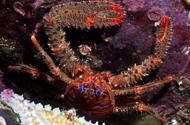Fifteen new Marine Protected Areas were created today, designed to protect important habitats and species.
The UK government has submitted the sites to the European Commission to be included within the European ‘Natura 2000’ network of protected areas.
The Natura sites are different to Marine Conservation Zones, which will be designated to protect nationally important and representative habitats and species.
Marine Conservation Zones in English inshore and English, Welsh and Northern Irish offshore waters are being identified through a different process to the Natura 2000 sites.
The new Natura sites were selected on the basis of the best scientific evidence available and have undergone a rigorous and transparent assessment.
They will bring protection to habitats including reefs, sea caves and sandbanks, where marine life thrives.
Sandbanks act as nursery grounds for many commercial fish species such as plaice and sole whilst also supporting sand eel communities that are a food source for seabirds and mammals such as seals.
Reefs support a colourful array of sponges, sea squirts and corals that provide shelter for crabs, lobsters and fish such as the multi-coloured cuckoo wrasse.
Birds will also benefit, with sites selected for the conservation of the red-throated diver and common scoter.
Together with Marine Conservation Zones, Ramsar sites, sites of special scientific interest and new protection in Scotland and Northern Ireland, the Natura sites will create the UK’s new network of marine protected areas.
Marine environment minister, Richard Benyon, said: “Our seas are home to some of the most diverse species and habitats in the world and they need just as much protection as our land.
“Today is a major step forward in helping us to achieve clean, healthy and vibrant seas where marine life can thrive.
“Working hand-in-hand with the creation of Marine Conservation Zones, created under the groundbreaking Marine and Coastal Access Act, these sites will make a major contribution to the delivery of an ecological network of Marine Protected Areas by 2012.”
Two consultations also start today for sites at the Dogger Bank in the North Sea and proposed new boundaries for Lune Deep and Prawle Point to Start Point.
The Dogger Bank is not only an important sandbank habitat but is also a key area for the UK meeting its renewable energy target by 2020.
The identification of the Dogger Bank as both a conservation site and an area for windfarm development illustrates the compatibility that can exist between energy development and nature conservation.
The consultations will close on 12th November 2010.
The new candidate Special Areas of Conservation are:
-
Inner Dowsing, Race Bank and North Ridge
-
North Norfolk Sandbanks and Saturn Reef
-
Haisborough, Hammond and Winterton
-
Margate and Long Sands
-
Bassurelle Sandbank
-
Lyme Bay and Torbay
-
Prawle Point to Plymouth Sound and Eddystone
-
Lizard Point
-
Land’s End and Cape Bank
-
Shell Flat
-
Red Bay
-
North-West Rockall Bank
-
Wyville Thomson Ridge
The new Special Protection Areas (for birds) are:
-
Outer Thames Estuary
-
Liverpool Bay/Bae Lerpwl (agreed with the Welsh Assembly Government)
The two possible SACs subject to another consultation by Natural England are:
-
Lune Deep
-
Prawle Point to Start Point
The possible SAC being consulted upon by JNCC is:
-
Dogger Bank
Further information on the Natura 2000 sites, new sites and the consultations may be found on:
www.naturalengland.org.uk/ourwork/marine/sacconsultation/default.aspx
www.jncc.gov.uk/marineconsult
www.doeni.gov.uk
Photographs: Paul Kay, Paul Naylor, Jim Greenfield.

 Get Involved
Get Involved








